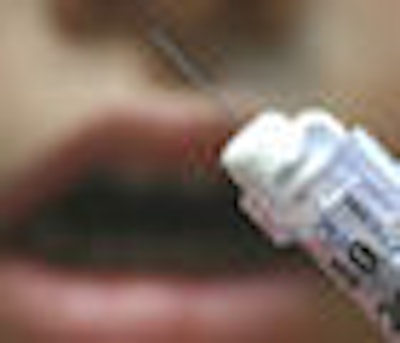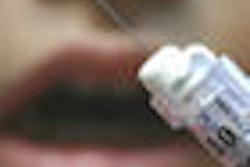
Every so often, a patient feels pain, prickling, numbness, altered taste, or some other unpleasant nerve symptom that lingers long after a shot of anesthetic. No one has nailed down the exact cause of nonsurgical paresthesia, but researchers from the University of Toronto are warning against the type of injection they believe is most likely to cause it.
“I would not recommend using a mandibular block of 4% articaine or prilocaine.”
— Daniel Haas, D.D.S., Ph.D.
"I would not recommend using a mandibular block of 4% articaine [Septocaine, Ultracaine] or prilocaine," said Daniel Haas, D.D.S., Ph.D., a University of Toronto anesthesia professor who presented a study on paresthesia at the recent International Association for Dental Research (IADR) meeting in Miami. "Infiltration is no problem."
Paresthesia isn't common, but it can be debilitating and sometimes lasts a lifetime, he added.
The Toronto team used a database from the Ontario Professional Liability Program to measure the incidence of nonsurgical paresthesia with various types of injection from 1999 through 2007. They found that about 1 in 553,000 local anesthesia injections resulted in paresthesia.
All but 2 of the 163 cases of paresthesia were mandibular blocks, so the risk is probably double for this procedure, Dr. Haas said. And in reality, even more patients may have the problem.
"Our feeling is this is probably underreported," he said. He speculated that dentists reported only the most serious cases -- those in which symptoms lasted for at least a couple of days -- to the Professional Liability Program.
The researchers also looked at what type of anesthetic dentists used in each case. They found that the largest portions of the cases involved articaine (60%) and prilocaine (17%).
They then surveyed Ontario dentists in 2007 to find out the overall use of these anesthetics. They found that only 44.2% of injections were articaine and 6.81% were prilocaine.
The researchers found that the disproportionate incidence of paresthesia occurring with articaine and prilocaine injections was statistically significant (p < 0.01).
One theory to explain paresthesia following an injection is that the needle strikes a nerve. But if that were true, the researchers reasoned, patients would most likely report a sort of electric shock type of pain at the moment of the injection. Though some patients in the database reported such a sensation, most didn't and there was no pattern that associated this pain with the type of symptom that followed.
The researchers also found no evidence that the patient's gender or the side of the mouth injected made a difference. So Dr. Haas thinks something about the chemical itself is causing the problem.
But why would articaine and prilocaine cause more paresthesia than the other three local anesthetics? "I don't think it's the drug at all, I think it's simply the concentration," Dr. Haas said. He pointed out that only articaine and prilocaine are sold in a 4% concentration in North America -- all the other local anesthetics come in a lower concentration.
Asked to comment, Paul Moore, D.M.D., Ph.D., M.P.H., the chair of dental anesthesiology at the University of Pittsburgh said, "There's conflicting data on articaine, but prilocaine keeps coming up." (Dr. Moore is a paid consultant to Septodont, the maker of Septocaine.)
Dr. Haas cited two other studies, including one that his team did with previous years of data from the same source, both of them finding an association between 4% articaine and paresthesia. But he acknowledged that his study doesn't prove that either of the drugs cause paresthesia in this concentration. "It's simply an association that's consistent with data that's come up before," he said.
Copyright © 2009 DrBicuspid.com



















